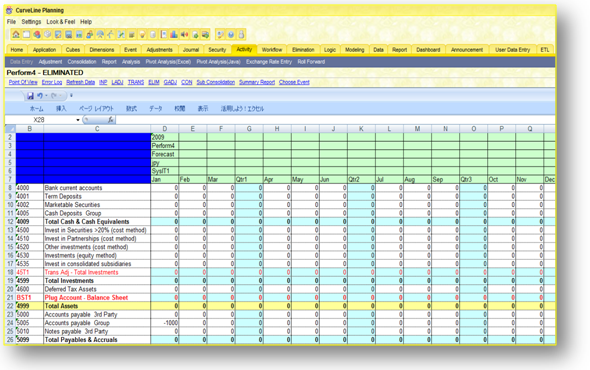InterCompany Elimination
Consolidated financial statements are required when there are two or more affiliated companies. When a parent company
either directly or indirectly controls a majority interest of a subsidiary, consolidated financial statements must be
presented. Consolidated financial statements present the results of operations, statement of cash flows, and financial
position of the combined entity. Separate accounting records are kept for each separate company, but not for the
consolidated entity. To determine the consolidated amounts, the amounts for the individual affiliated companies are
added together. Elimination entries are made to remove the effects of inter-company transactions.
When one company acquires another company, a consolidated balance sheet needs to be prepared. The first step is to
eliminate the effects of any inter-company transactions. There are three basic types of inter-company eliminations
. The first type is the elimination of inter-company stock ownership. This entry eliminates both the asset and the
stockholders’ equity accounts for the parent company’s ownership of the subsidiary.
The second type of inter-company elimination is the elimination of inter-company debt. When the parent company makes
a loan to a subsidiary, the parent company would have a note receivable and the subsidiary a note payable. When the
two companies are consolidated, or combined, the loan is just a transfer of cash, so both the note receivable and
note payable are eliminated.
The third type of inter-company elimination is the elimination of inter-company revenue and expenses. These inter-company
revenues and expenses are eliminated since they are really just transfers of assets from one affiliated company to another
and have no effect on consolidated net assets. Some examples of inter-company revenues and expenses are sales to affiliated
companies, cost of goods sold as a result of sales to affiliated companies, interest expense or revenue on loans to or
from affiliated companies, and rent or other revenue received or paid for services either rendered to or received from
affiliated companies.
An important item to understand in regard to consolidated financial statements is the concept of minority interest.
A minority interest exists when a parent company owns a majority interest in a subsidiary, but not 100% of the
outstanding shares. In this case, the minority interest would be shown on the balance sheet as a type of ownership
equity. The minority interest is the ownership interest in the subsidiary that is held by stockholders other than
the parent company. Since there are minority stockholders, just the amount of the stockholders{f equity that is
owned by the parent company is eliminated.
One of the GAAP guidelines related to consolidated financial statements states that the retained earnings of a
subsidiary company that were created before the date of its acquisition can’t be included in the consolidated
retained earnings of the parent company and its subsidiaries. In addition, any dividends declared from those
retained earnings can’t be included in the parent company’s net income. GAAP also states that comparative
financial statements are preferred for annual reports.
Curveline planning intercompnay elimination as the following features:
1. Different intercompnay elimination groups can be set. Based on the different intercompany elimination group settings
elimination will automatically happen.
2. Elimination will happen at a common parent level.
3. A common elimination entity settings can be used to eliminate all the intercompnay transaction in a common entity
level.
4. Intercompany
If you need help with your consolidated financial statements, audit, income taxes, general accounting, or
other financial reporting, you are in the right place. Please try out the CPA search feature on this website
to find a qualified professional in your area to assist you with all your accounting and tax needs.
Deduction of intercompany items when preparing the combining or consolidated balance sheet and income statement.
Examples are intercompany loans and intercompany investments between the parent and subsidiary. In the case of
extensive eliminations, an eliminations ledger may be used.

Click for price details
Click to contact for more details
Click for brochure
|
